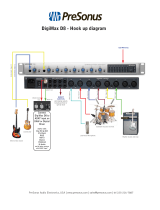
3
OVERVIEW
Introduction
Thank you for purchasing this Third Generation Scarlett 18i20, one of the family of Focusrite
professional computer interfaces incorporating high quality Focusrite analogue preamps. In
conjunction with the unit’s accompanying software application, Focusrite Control, you now have a
compact yet highly versatile solution for routing high quality audio to and from your computer. You
can also use the Scarlett 18i20 as a “stand-alone” interface to any other type of recording device,
once you have configured it using Focusrite Control.
Focusrite Control, and several other exciting and useful software applications, can be downloaded
free of charge once you have registered your product. Note that a separate Focusrite Control User
Guide is also available; we strongly recommend that you download this as well.
In developing the Third Generation series of Scarlett interfaces, we have made further improvements
to both performance and features. Audio specifications have been upgraded throughout the unit to
give you greater dynamic range and even lower noise and distortion; additionally, the mic preamps
now accept higher input levels. An important enhancement is the inclusion of Focusrite’s AIR function.
Individually selectable on each channel, AIR subtly modifies the preamp’s frequency response to
model the sonic characteristics of our classic transformer-based ISA microphone preamps. When
recording with good quality microphones, you will notice an enhanced clarity and definition in the
important mid to high frequency range, just where it is most needed for vocals and many acoustic
instruments. Third Generation Scarlett interfaces are class compliant on macOS: this means they
are plug-and-play, so no need to install a driver if you are a Mac user.
Your Third Generation Scarlett interface is compatible with our Focusrite Control software application:
this lets you control various hardware features, set up monitor mixes and configure routings. There
is a Focusrite Control installer for both Mac and Windows platforms, and no driver is required for
Macs. The Windows version of the installer contains the driver, so in either case, you only need to
install Focusrite Control to get up and running.
This User Guide provides a detailed explanation of the hardware to help you achieve a thorough
understanding of the product’s operational features. We recommend that you take the time to read
through the User Guide, whether you’re new to computer-based recording or a more experienced
user, so that you are fully aware of all the possibilities that the Scarlett 18i20 and accompanying
software have to offer. If the main User Guide sections do not provide the information you need,
be sure to consult https://support.focusrite.com/, which contains a comprehensive collection of
answers to common technical support queries.
Features
The Scarlett 18i20 audio interface caters for a total of 18 inputs and 20 outputs, and provides the
means to connect microphones, musical instruments, line level audio signals and digital audio
signals in both ADAT and S/PDIF formats to a computer running compatible versions of macOS or
Windows via one of the computer’s USB ports. In the Third Generation, the optical ADAT ports also
support “Dual ADAT” operation (S/MUX II), which provide 8 channels of audio at 88.2/96 kHz as well
as at 44.1/48 kHz.
The signals at the physical inputs can be routed to your audio recording software / digital audio
workstation (referred to throughout this user guide as the “DAW”) at up to 24-bit, 192 kHz resolution;
similarly, the DAW’s monitor or recorded output signals can be configured to appear at the unit’s
physical outputs.




















